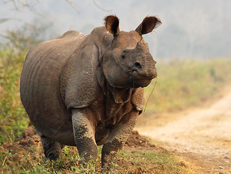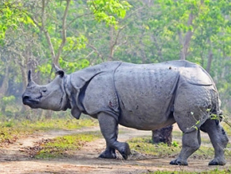 info@kaziranga-national-park.com
info@kaziranga-national-park.com + 9212777225 / 9212553107
+ 9212777225 / 9212553107

- Home/
- Kaziranga Wildlife Special /
- Great Indian One-Horned Rhinoceros
Great Indian One-Horned Rhinoceros

The Great one horned rhino is commonly found in Nepal, Bhutan, Pakistan and in Assam, India. It is confined to the tall grasslands and forests in the foothills of the Himalayas. The Indian Rhinoceros can run at speeds of up to 25 mph (40 km/h) for short periods of time and is also an excellent swimmer. It has excellent senses of hearing and smell, but relatively poor eyesight.
However, no more than 2,000 remain in the wild, with only two populations containing more than 100 rhinos: Kaziranga National Park in Assam, India (1,200) and Chitwan National Park (CNP), Nepal (600). Despite joint efforts between Bhutan and India, the survival of a small population of rhinos living along the Indo-Bhutan border in Manas still remains doubtful (Jnawali et.at, 2000).
Physical Appearance

Indian Rhinos are brownish-gray in color and are hairless. They have knobby skin that appears to be armor-plated. A single horn sits on top of their snout, and their upper lip is semi-prehensile.
The largest of the Asian rhinos, male Indian rhinos weigh approximately 2,200 kg (nearly 4,840 pounds) and range in height from 170 to 186 cm (67 to 73 inches) and are 368 to 380 cm (145 to 150 inches) long. Their horn can grow to 45 cm (18 inches)! Females* are smaller, weighing only 1,600 kg (3527 pounds) and standing 148 to 173 cm (58 to 68 inches) tall. Female Indian rhinos are 310 to 340 cm (122 to 134 inches) long. A female is pregnant for 16 before giving birth. *Note: black, Sumatran, and Javan rhino females are similar in size to the male of the species.
Conservation
The Indian and Nepalese governments have taken major steps toward Indian Rhinoceros conservation with the help of the World Wildlife Fund (WWF). The Kaziranga National Park and Manas National Park in Assam, Pobitora reserve forest in Assam (having the highest Indian rhino density in the world), Orang National park of Assam, Laokhowa reserve forest of Assam having a very small population and Royal Chitwan National Park in Nepal are homes for this endangered animal.
 Share
Share Home
Home Packages
Packages Book Now
Book Now